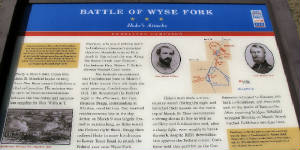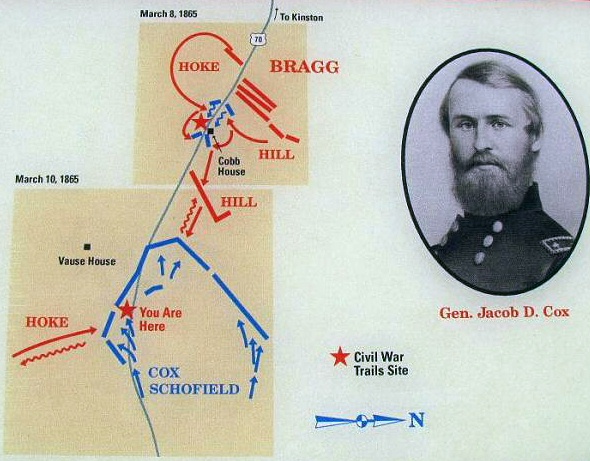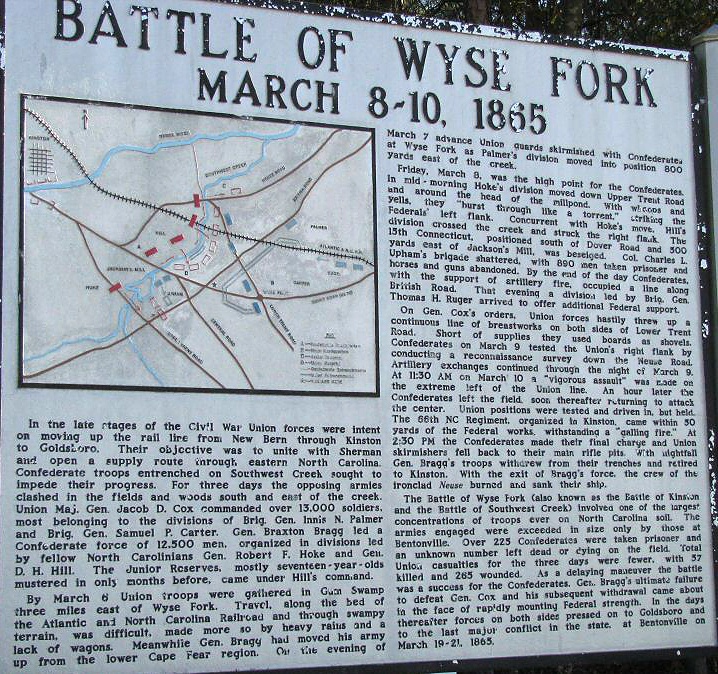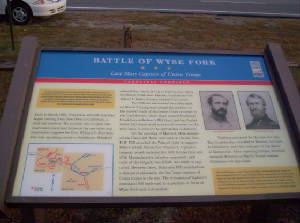|
| Battle of Wyse Fork History and Map |

|
| 2nd Battle of Kinston |
BATTLE OF WYSE FORK: A HISTORY
(AKA 2ND BATTLE OF KINSTON)
MARCH 8-10, 1865
In the late stages of the Civil War the Union forces were intent on moving up the rail line from New
Bern through Kinston to Goldsboro. Their objective was to unite with Sherman and open a supply route through eastern North
Carolina. Confederate troops entrenched on Southwest Creek sought to impede their progress. For three days the opposing armies
clashed in the fields and woods south and east of the creek. Union Maj. Gen. Jacob D. Cox commanded over 13,000 soldiers,
most belonging to the divisions of Brig. Gen. Innis N. Palmer and Brig. Gen. Samuel P. Carter. Gen. Braxton Bragg led a Confederate
force of 12,500 men, organized in divisions led by fellow North Carolinians Gen. Robert F. Hoke and Gen. D. H. Hill. The Junior
Reserves, mostly seventeen-year-olds mustered in only months before, came under Hill’s command.
| Union & Confederate Battlefield Troops - Movements |

|
| (Civil War Map and Photograph of General Cox) |
| Battle of Wyse Fork Map |

|
| Battle of Kinston Map |
By March 6, Union troops were gathered in Gum Swamp three miles east of
Wyse Fork. Travel, along the bed of the Atlantic and North Carolina Railroad and through swampy terrain, was difficult, made
more so by heavy rains and a lack of wagons. Meanwhile Gen. Bragg had moved his army up from the lower Cape Fear region. On
the evening of March 7, advance Union guards skirmished with Confederates at Wyse Fork as Palmer’s division moved into
position 800 yards east of the creek.
Friday, March 8, was the high point for the Confederates. In mid-morning
Hoke’s division moved down Upper Trent Road and around the head of the millpond. With whoops and yells, they “burst
through like a torrent,” striking the Federals’ left flank. Concurrent with Hoke’s move, Hill’s division
crossed the creek and struck the right flank. The 15th Connecticut, positioned south of Dover Road and 500 yards east of Jackson’s
Mill, was besieged. Col. Charles L. Upham’s brigade shattered, with 890 men taken prisoner and horses and guns abandoned.
By the end of the day Confederates, with the support of artillery fire, occupied a line along British Road. That evening a
division led by Brig. Gen. Thomas H. Ruger arrived to offer additional Federal support.
| Battle of Wyse Fork Historical Marker |

|
| (2nd Battle of Kinston Civil War History) |
| 2nd Battle of Kinston, North Carolina |

|
| (Second Battle of Kinston) |
On Gen. Cox’s orders, Union forces hastily threw up a continuous line
of breastworks on both sides of Lower Trent Road. Short of supplies they used boards as shovels. Confederates on March 9 tested
the Union’s right flank by conducting a reconnaissance survey down the Neuse Road. Artillery exchanges continued through
the night of March 9. At 11:30 AM on March 10, a “vigorous assault” was made on the extreme left of the Union
line. An hour later the Confederates left the field, soon thereafter returning to attack the center. Union positions were
tested and driven in, but held. The 66th NC Regiment, organized in Kinston, came within 50 yards of the Federal works, withstanding
a “galling fire.” At 2:30 PM the Confederates made their final charge and Union skirmishers fell back to their
main rifle pits. With nightfall Gen. Bragg’s troops withdrew from their trenches and retired to Kinston. With the exit
of Bragg’s force, the crew of the ironclad Neuse burned and sank their ship.
The Battle of Wyse Fork (also known as the 2nd Battle of Kinston and the
Battle of Southwest Creek) involved one of the largest concentrations of troops ever on North Carolina soil. The armies engaged
were exceeded in size only by those at Bentonville. Over 225 Confederates were taken prisoner and an unknown number left dead
or dying on the field. Total Union casualties for the three days were fewer, with 57 killed and 265 wounded. As a delaying
maneuver the battle was a success for the Confederates. Gen. Bragg’s ultimate failure to defeat Gen. Cox and his subsequent
withdrawal came about in the face of rapidly mounting Federal strength. In the days thereafter forces on both sides pressed
on to Goldsboro and to the last major conflict in the state, at Bentonville on March 19-21, 1865.
Return to American Civil War Homepage
Best viewed with Internet Explorer or Google Chrome
google.com, pub-2111954512596717, DIRECT, f08c47fec0942fa0
|

